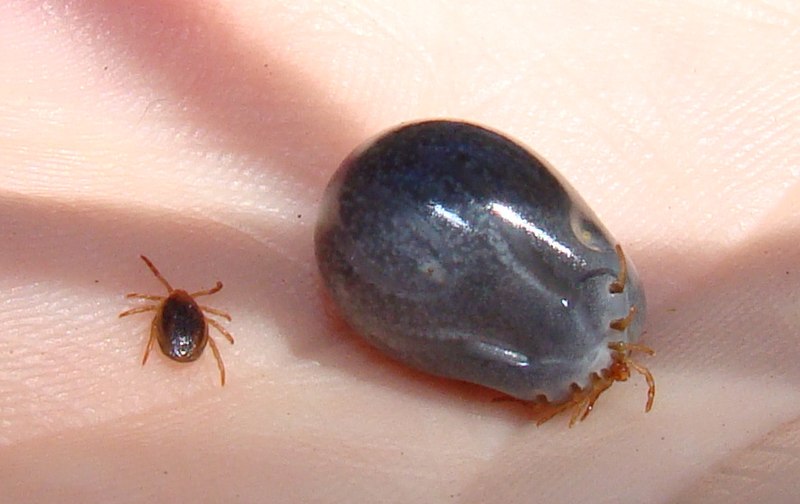SCORES & OUTDOORS: Two other types of illnesses connected with ticks
 by Roland D. Hallee
by Roland D. Hallee
This week, I will share with you a press release I received from Nancy Bostrom, of American Family Care. In the early days of summer 2023, local healthcare providers are sounding an alarm about a triple tick threat that includes a rare illness that just killed a man!
While Lyme disease – considered one of the most common tick-borne diseases is usually the biggest concern this time of year – local healthcare providers at American Family Care (AFC) are spreading the word about two other types of illnesses associated with the blood-sucking insects.
They’ve even launched an educational campaign called Tick Talk so local families know what to look out for while outdoors this summer and how to protect themselves.
Powassan Virus
Powassan virus is a non-treatable illness transmitted by the same black legged (or deer ticks) that carry Lyme Disease. Just a few weeks ago, health officials in Maine confirmed a man was pronounced dead from the disease.
So far this year, two cases of Powassan Virus have been reported. The CDC has tracked nearly 300 cases, including 264 hospitalizations since 2014, but experts fear many cases are unreported.
Symptoms can include fever, headache, vomiting, weakness, confusion, seizures or even memory loss. Ten percent of those who contract Powassan will die. Approximately one half will have long term health problems like recurring headaches, loss of muscle strength, and memory problems.
Big difference from Lyme – It takes Lyme Disease many hours (at least 24) to be transmitted from tick to person. It is suspected that Powassan Virus is transmitted from the tick to person in just 15 minutes.
Babesiosis
Babesiosis is another tickborne illness on the rise. Unlike the Powassan virus, babesiosis is treatable if caught early. This illness can also be transmitted by a tick that is also carrying Lyme.
Federal health officials say cases of tickborne illness have skyrocketed over an 8-year period.
Symptoms can include fever, chills, lethargy, joint pain, body aches, loss of appetite, nausea or fatigue – things that can appear to overlap with Lyme disease, but there is no distinctive bullseye rash.
If left untreated, it can lead to acute respiratory distress syndrome (ARDS), severe anemia, congestive heart failure, renal failure, disseminated intravascular coagulation (DIC), shock and coma.
Lyme Disease
Lyme disease is the most known of the tickborne illnesses. It is transmitted through the bite of an infected deer tick. Cases of Lyme disease have more than tripled since 1993 according to the Centers for Disease Control and Prevention (CDC).
Lyme disease causes a rash that looks like a bullseye. It also causes flu-like symptoms, such as fever, chills, headache, fatigue, and muscle aches.
Lyme disease may evolve through phases, which can overlap and cause ever worsening symptoms that may involve the skin, joints, heart, or nervous system.
Antibiotics are effective treatments for Lyme disease when detected early.
Protect Yourself
Remember, ticks can typically be found in grassy, brushy, or wooded areas, or on animals. They typically wait on the tips of branches, leaves, or tall grasses for prey to walk by.
A tick’s saliva has anesthetic properties, so you may not even realize you’ve been bitten.
When spending time outdoors, be aware of your surroundings and the possibility of ticks in the area. Wear insect repellent with DEET. If you must be in a grassy or wooded area, wear long sleeves and long pants. Tucking your pants into your socks for extra protection. Shower immediately after being outside. Ask someone check your body for ticks. If you find a tick on your body, time is of the essence! Use fine-tipped tweezers to grasp it by the head as close to the skin as possible. Gently pull the tick upward, making sure not to twist or squeeze it. Wash and disinfect the area with rubbing alcohol or soap and water.
Save the tick!
Take a photo of the tick and submit to a tick identification website which can inform you of the potential pathogens it could be carrying and whether you might want to have the tick tested as a further assessment of disease risk.
Protection is the key, however, if you do come in contact with a tick, don’t wait. If you’re not sure, seek professional medical help.
Roland trivia question of the week:
Name the only two players to win a World Series with both the Boston Red Sox and New York Yankees.
Responsible journalism is hard work!
It is also expensive!
If you enjoy reading The Town Line and the good news we bring you each week, would you consider a donation to help us continue the work we’re doing?
The Town Line is a 501(c)(3) nonprofit private foundation, and all donations are tax deductible under the Internal Revenue Service code.
To help, please visit our online donation page or mail a check payable to The Town Line, PO Box 89, South China, ME 04358. Your contribution is appreciated!



Leave a Reply
Want to join the discussion?Feel free to contribute!